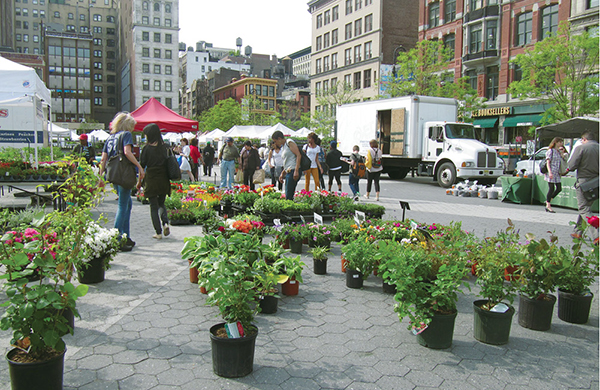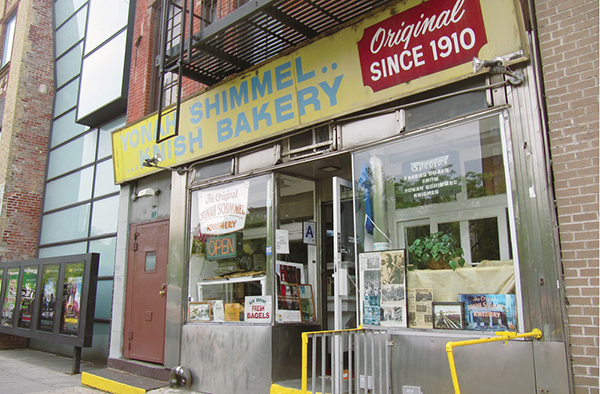7
Early East Side Ethnic Enclaves
Several days a week, Union Square, at the starting point of your journey, hosts one of the city’s largest farmers’ markets, where regional farmers peddle produce much like earlier settlers did via pushcart on the streets of the Lower East Side in the nineteenth century. Some of these early pushcart enterprises grew into thriving businesses that continue to serve the community today. This ride tours through the vibrant neighborhoods of the East Village, the Lower East Side, Chinatown, and Little Italy, passing several such longstanding establishments—cafes, eateries, bars, and merchants—along the way. It’s a great ride for anyone interested in the city’s early ethnic enclaves, a taste for Old World specialty foods, and some urban cycling savvy.
Start: The northeastern corner of Union Square
Length: 7.3-mile loop
Approximate riding time: 1.5 hours
Best bike: Hybrid, road, or mountain bike
Terrain and trail surface: The trail is paved throughout except for 1 block on Broome Street, which is cobbled. The terrain is flat.
Traffic and hazards: While most of this ride follows bike lanes and bike routes, it’s still a deep-city route. Streets are narrow and traffic—although slow—can be heavy. Throughout the journey, stay especially alert along the avenues, where autos travel more quickly. Urban cycling comfort is thus beneficial.
Things to see: Union Square, McSorley’s Old Ale House, Cooper Union, The Original Vincent’s, Alleva Dairy, Caffe Roma, Seward Park Library, Essex Street Market, Yonah Schimmel Knish Bakery, Russ & Daughters, Katz’s Delicatessen, Tompkins Square Park
Map: New York City Bike Map
Getting there: By public transportation: Take the 4, 5, 6, N, Q, R, or L subway to the Union Square station. Exit the station at the north end. GPS coordinates: N40 44.198’ / W73 59.361’
THE RIDE
From Union Square, your journey begins by heading south across East 14th Street, often considered the northern boundary to downtown Manhattan. Stay alert on Broadway, where traffic can be heavy, as you pass the storied Strand Bookstore on your left. It opened at a nearby spot in 1927. East 10th Street then leads along residential blocks into the East Village. This soon brings you on East 7th Street past McSorley’s Old Ale House, opened by an Irish-born immigrant, John McSorley, around 1860. At the end of the block, you’ll brush up against Cooper Union, established in 1859 by McSorley’s close friend, Peter Cooper, as an institute of higher learning where all incoming students received full scholarships. The school’s landmark foundation building sits at the north end of Cooper Square, across 3rd Avenue. Its modern counterpart, completed in 2009, forms a striking architectural contrast just south of East 7th Street.
Proceeding southward, you’ll approach Houston Street along 2nd Avenue, where you’ll merge left to continue straight. Use caution here as this intersection gets heavy traffic. Entering the Lower East Side on the other side, you’ll skirt the edge of Sara D. Roosevelt Park, with ball courts and playgrounds stretching south toward the Manhattan Bridge. A short stretch of cobblestones along Broome Street then brings you into Chinatown and Little Italy. Heading south on Mott Street, one of Chinatown’s main drags, Asian grocers and bakeries line the way until you reach a long-standing, family-owned Italian eatery, The Original Vincent’s, at the corner of Hester Street. In 1904, a young Sicilian couple opened a small clam bar at this spot and, proving successful, soon moved into a small storefront. They named the spot after their son Vincent. Today, one of the couple’s relations, also named Vincent, continues to serve locals and tourists Old World Italian food.
Continuing onward, Mulberry Street leads through the heart of Little Italy, with Italian restaurants lining the way. The Italian American Museum, on your left at Grand Street, sits in what was once Banca Stabile, a bank that in the late nineteenth century served newly arrived Italian immigrants. Crossing Grand Street, you’ll pass Alleva Dairy on your right, another early Italian establishment. This latteria was founded just a few blocks east of here in 1892 by Pina Alleva, an immigrant from a small town near Naples. It is reputedly America’s oldest Italian cheese store and now run by Alleva’s grandson. Stop off to pick up some Italian delicacies if you wish before continuing northward through Little Italy. At Broome Street, you’ll hit upon another Old World remnant, Caffe Roma, which began as a popular saloon in the 1870s. A decade or two later, the spot was transformed into a pasticceria by a pair of Neapolitan brothers. They later sold it to a fellow Neapolitan, Vincento Zeccardi, whose grandson continues to serve traditional Italian coffee and sweets—Neapolitan tiramisu, pignoli, biscotti—today. Some of the interiors endure from its early years as a saloon.

The Union Square Greenmarket.
Up ahead, Mott Street then returns you to Chinatown, bringing you to another main Chinatown drag along Grand Street. You’ll cycle past an array of Chinese seafood, fruit, and vegetable merchants, as well as street vendors selling everything from pork buns to dumplings to fish balls. As you traverse Sara D. Roosevelt Park, you’ll pass handball courts on your right, bustling with activity until late at night. Farther south beyond that, you might catch glimpses of a large-scale exercise gathering—people come together for communal Tai Chi, fan dance, and similar sessions at all hours of the day (or night).
East of the park you enter what was the epicenter of immigrant life in the late nineteenth century—the Lower East Side. You’ll pass Harris Levy, a long-standing merchant of linens and fabrics, at 278 Grand St. Founded in the late nineteenth century by a young immigrant couple who began hawking wares from a rented pushcart, the family-owned and -operated importer today sells fine linens, tablecloths, comforters, and the like. Continuing onward, a protected greenway along the median of Allen Street brings you deeper into the Lower East Side. Pass another long-standing neighborhood retailer, Mendel Goldberg Fabrics, up ahead at 72 Hester Street, also founded in the late nineteenth century. This former merchant of notions today continues in the hands of its founder’s grandson and great-granddaughter and specializes in high-end fabrics. Next, you’ll reach Orchard Street, a main pushcart passageway in the nineteenth century, but today lined with trendy stores and boutiques on the ground floors of former tenement dwellings.
Grand Street then brings you toward a newer section of Chinatown. The area surrounding East Broadway was once home to a large Jewish community, but today the neighborhood attracts mainly Chinese immigrants. The Seward Park Library, a four-story redbrick building in the park on your right along East Broadway, stands testament to this development. Serving a mostly Jewish clientele when it opened in 1909, it today stocks an extensive selection of Chinese materials. From the southwest corner of Seward Park, you’ll then return northward toward the East Village. Along the way, stop off at the Essex Street Market on your right to pick up some fresh produce or ethnic specialties for a break toward the end of your journey in Tompkins Square Park up ahead. Before getting there, you’ll pass a host of Jewish eateries with a history along East Houston Street—Yonah Schimmel Knish Bakery, Russ & Daughters, and Katz’s Delicatessen (see sidebar for descriptions)—and then reach Tompkins Square Park, an East Village backbone, off Avenue A. Take a break here before returning to your starting point at Union Square.
McSorley’s Old Ale House
One of the bar’s claims to fame is that then-Congressman Abraham Lincoln stopped at the watering hole when he came to New York for his infamous Cooper Union speech in 1860. Not much at the saloon has changed since then, with almost all the paraphernalia that lines the walls dating back to at least 1910, when McSorley died at age 87. One difference is that McSorley’s today serves women as well as men. The spot was a men-only affair until 1970, when it became illegal to prohibit women from entering. McSorley’s maxim had been that it would be impossible for men to drink in peace in the presence of women.

MILES AND DIRECTIONS
0.0 Go south on Union Square East, hugging the east edge of Union Square. Continue straight onto Broadway after crossing East 14th Street.
0.4Turn left onto East 10th Street.
0.7Turn right onto 2nd Avenue. Although there’s a separated bike path along the east edge of the avenue, you might want to stick to the west side, so you can easily turn right again a few blocks south.
0.8Turn right onto East 7th Street.
1.0Turn left onto 3rd Avenue.
1.2Turn left onto East 2nd Street.
1.3 Turn right onto 2nd Avenue. Second Avenue forks up ahead, with traffic headed south taking the central lane. Merge left to continue along the bike lane going south. Stay alert as cars turning right will be on your right, and cars going straight will be on your left.
1.4Cross East Houston Street and continue straight onto Chrystie Street, continuing along the bike lane.
1.8Turn right onto Broome Street.
2.0Turn left onto Mott Street.
2.1Turn right onto Hester Street, followed by a right onto Mulberry Street.
2.4Turn right onto Spring Street, followed by a right onto Mott Street.
2.7Turn left onto the bike lane on Grand Street, hugging the southern edge.
2.9Turn left onto Forsyth Street. A separated bike lane hugs Sara D. Roosevelt Park on your left.
3.2 Turn right onto Stanton Street.
3.3At Allen Street, cross to the median to catch the separated bike lane going south (right).
3.6Turn left onto Hester Street, followed by a left onto Orchard Street.
3.8Turn right onto Grand Street onto the bike lane.
4.0Turn right onto Clinton Street.
4.1Turn right onto East Broadway. Veer right after passing the gates to Seward Park Library, hugging the edge of Seward Park on your right.
4.2Turn right onto Essex Street.
4.7After passing the Essex Street Market on your right, turn left onto Rivington Street.
4.9Turn right onto Forsyth Street, where the bike lane hugs the edge of the park.
5.0Turn right onto East Houston Street. East Houston has heavy traffic so stay alert.
5.3Turn left onto Avenue A, catching the on-road bike lane along the eastern edge of the road.
5.7Turn left onto East 9th Street.
5.8Cross 1st Avenue and then turn right onto the on-road bike lane on 1st Avenue, hugging the west side of the road.
6.4 Turn left onto East 21st Street.
7.0Cross Broadway to catch the on-road bike lane heading south on Broadway along the western edge of the road.
7.2Cross East 17th Street to turn left onto the bike path that hugs the northern edge of Union Square.
7.3Arrive at your starting point.
RIDE INFORMATION
Local Events/Attractions
Alleva Dairy: 188 Grand St.; (212) 226-7990; www.allevadairy.com
Caffe Roma: 385 Broom St.; (212) 226-8413
Essex Street Market: 120 Essex St.; www.essexstreetmarket.com
Katz’s Delicatessen: 205 E. Houston St.; (212) 254-2246; katzsdelicatessen.com
McSorley’s Old Ale House: 15 E. 7th St.; (212) 473-9148
The Original Vincent’s: 119 Mott St.; (212) 226-8133; http://02de1be.netsolhost.com/index.htm
Russ & Daughters: 179 E. Houston St.; (212) 475-4880; www.russanddaughters.com
Yonah Schimmel Knish Bakery: 137 E. Houston St.; (212) 477-2858; knishery.com
Restrooms
Mile 5.7: There are restrooms in the park building in Tompkins Square Park.

The storefront of the Yonah Schimmel Knish Bakery, established on East Houston Street in 1910, when the Lower East Side’s population peaked at 550,000.